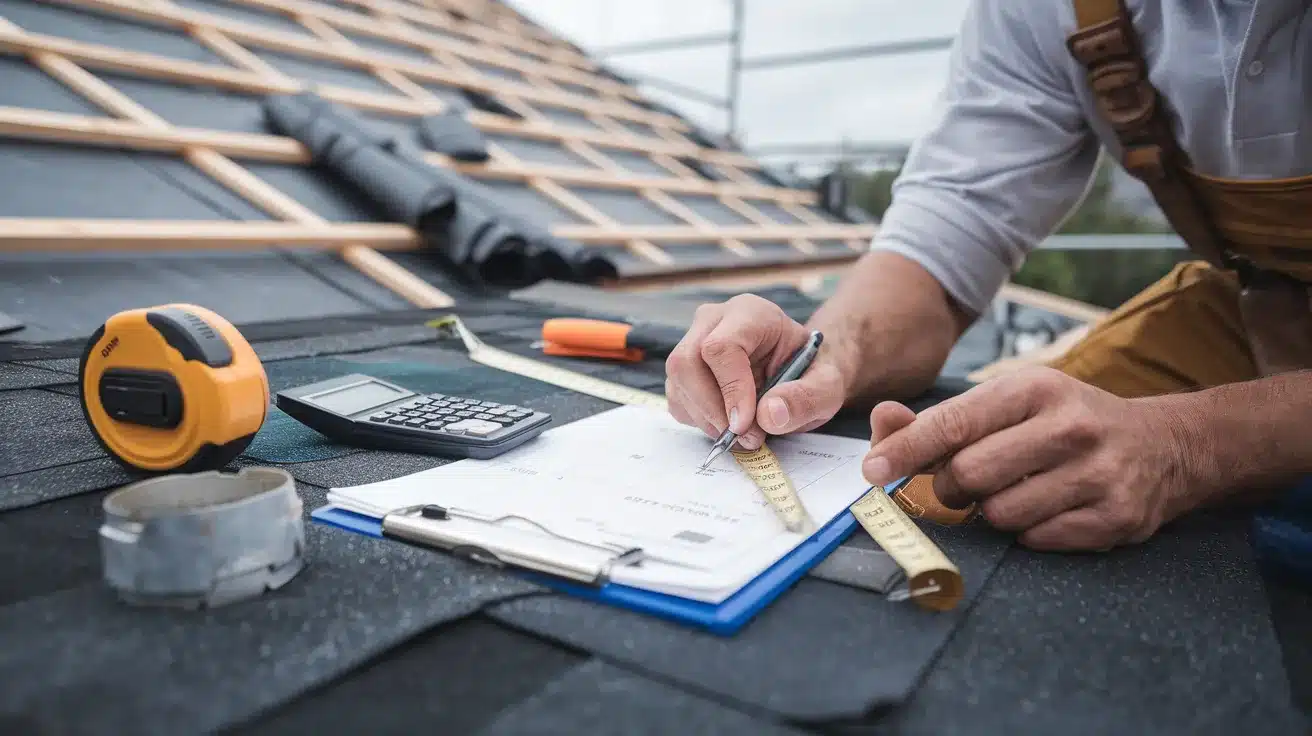Roofing bills can shock homeowners who aren’t prepared for the true costs involved. Most people focus only on materials but forget that labor makes up 60% of total roofing expenses. This gap in knowledge leads many to pay too much or hire poor-quality workers.
Want to avoid overpaying for your next roof job? Knowing the standard labor rates per square (100 square feet) puts you ahead when getting quotes from contractors.
This guide breaks down real roofing labor costs by region, roof type, and job difficulty. You’ll learn what affects pricing and how to spot fair quotes from overpriced ones.
Let’s examine what you should actually pay for roofing labor per square.
What Does “Per Square” Mean in Roofing?
“Persquare” is a standard measurement method used by roofing professionals to calculate costs. One roofing square equals 100 square feet of roof area. This unit helps contractors give clear estimates and makes it easier to compare prices.
When roofers talk about costs “per square,” they’re referring to how much they charge to install or replace roofing materials for each 100-square-foot section. This includes both the materials and the work needed to install them.
For example, if a contractor quotes $300 per square, that means you’ll pay $300 for every 100 square feet of your roof. So if your roof is 20 squares (2,000 square feet), the total cost would be $6,000.
Using the square measurement system lets both homeowners and contractors speak the same language when discussing project scope and pricing. It’s a quick way to understand the size of your roof job without getting into complex measurements.
Factors That Affect Roofing Labor Costs
Understanding what affects the cost of roofing labor can help you budget effectively and avoid surprises.
1. Roof Pitch and Design: The steepness of your roof affects how quickly workers can move. Steep roofs need extra safety gear and take more time, which raises costs. Complex designs with many angles also need more work hours.
2. Material Type: Different roofing materials need different skill levels. Asphalt shingles are simpler to install than slate tiles or metal panels. More complex materials mean higher labor rates.
3. Removal of Old Roofing: Taking off existing layers adds to labor time. Multiple layers or damaged decking underneath mean more work and higher costs.
4. Location and Season: Where you live matters. Labor rates vary by region due to local costs of living. Weather also plays a role – summer is peak season with higher rates, while winter may offer lower prices in some areas.
5. Accessibility: Homes with hard-to-reach roofs cost more. If trucks can’t park close by or workers need special equipment to access your roof, expect higher labor costs.
6. Building Codes: Local building requirements can affect how much work is needed. Some areas need extra steps like special water barriers or ventilation systems that add to labor time.
Average Roofing Labor Costs per Square
When planning for a roof project, knowing the typical labor costs helps you budget properly. Labor costs make up about 60% of your total roofing bill, with materials making up the rest.
National Average Costs
For asphalt shingle roofs (the most common type):
- Basic labor: $150-$200 per square
- Mid-range jobs: $200-$250 per square
- Complex jobs: $250-$400+ per square
Regional Price Differences
Labor costs vary widely by location:
- West Coast/Northeast: $200-$400 per square
- Midwest: $150-$300 per square
- South: $120-$280 per square
These differences come from local living costs, competition among roofers, and regional building rules.
Cost by Roof Type
Different roof materials need different labor skills:
- Asphalt shingles: $150-$300 per square
- Metal roofing: $350-$500 per square
- Tile or slate: $500-$800 per square
- Flat roofs: $200-$350 per square
Labor Breakdown
The labor cost includes several tasks:
- Removal of old roofing: $40-$80 per square
- Basic installation: $100-$200 per square
- Flashing work: $20-$40 per square
- Clean-up: $10-$30 per square
These figures help you understand what goes into the labor portion of your roofing quote.
Save Smart: Tips to Cut Down on Roofing Labor Expenses
Getting a new roof doesn’t have to break the bank. With some planning and smart choices, you can lower your labor costs while still getting quality work.
1. Pick the Right Season
Plan your roofing project during the off-season when possible. Fall and spring often have lower rates than summer.
Winter can offer the best deals in milder climates. Many roofers give discounts during their slow months to keep their crews busy and maintain cash flow.
2. Bundle Projects Together
Combine roofing work with other home upgrades for maximum savings. Doing gutters and roofing at once saves on setup costs since the crew is already on site.
Add roof vents during a replacement rather than later as a separate job. Fix any chimney issues during roof work to avoid paying for scaffolding twice. This combined approach reduces overall labor hours.
3. Clear Access for Workers
Make the job easier for your roofing crew to speed up the process. Clear the driveway for material delivery so trucks can get close to your home. Trim tree branches that might block roof access to prevent work delays.
Move items away from the house perimeter so workers can move freely and set up ladders safely. These simple steps can shave hours off the total job time.
4. Consider Partial Replacement
Full roof replacement isn’t always needed, which can save substantial labor costs. Ask if damaged sections can be fixed instead of replacing everything. See if just one slope or side needs work rather than the entire roof.
Get a professional opinion on repair vs. replace options to understand all choices. A targeted approach often requires fewer labor hours.
5. Get All Permits in Order
Handle paperwork ahead of time to prevent costly delays. Apply for permits before work begins to avoid having crews wait on-site.
Check with your HOA for any needed approvals well in advance. Make sure local building codes won’t cause delays mid-project that could extend labor hours. Proper planning keeps the project moving efficiently.
These tips can cut labor hours, reduce crew time, and help bring down the cost of your roofing project without cutting corners on quality.
Labor vs. Materials: What’s Driving the Cost of Your Roof?
| Cost Factor | Typical Percentage | What It Includes | Why It Matters |
|---|---|---|---|
| Labor | 60-70% | Worker wages, insurance, equipment, setup/cleanup time, overhead costs | Quality installation is crucial for roof performance and longevity; skilled labor costs more but provides better results |
| Materials | 30-40% | Shingles, underlayment, flashing, nails, ridge caps, vents, drip edge | Material quality affects durability; higher-quality materials cost more upfront but may last longer |
| Roof Removal | 15-20% (part of labor) | Stripping old materials, disposal fees, and dumpster rental | More layers or damaged decking increase removal time and costs |
| Overhead & Profit | 20-25% (built into both) | Business costs, insurance, office expenses, and warranty coverage | Legitimate business overhead ensures proper insurance and warranty coverage |
| Pitch Factor | 0-30% (adjustment) | Extra safety equipment, slower installation, and additional workers | Steeper roofs require more time and safety measures, increasing labor costs |
| Accessibility | 0-15% (adjustment) | Special equipment rental, extra time for material transport | Hard-to-reach roofs require more time and special equipment |
Note: Percentages may overlap as some categories (like removal) are typically included within the broader labor category.
Conclusion
Now you understand what goes into roofing labor costs per square and how to assess if quotes are fair. From the basic measurement system to the factors that influence pricing, you have the tools to make informed decisions about your roof project.
Remember that good roofing work is an investment in your home’s safety and value. While it’s smart to find ways to reduce costs, focusing only on the lowest bid might lead to bigger expenses later.
The next time you need roof work, you’ll know what questions to ask, what season might offer better rates, and how to prepare your property to help the job go smoothly. This knowledge puts you in control when planning your next roofing project.
Frequently Asked Questions (FAQs)
1. How Much Should I Charge to Do a 22 Square Foot Roof?
If you mean 22 roofing squares (2,200 square feet), typical labor charges range from $3,300-$6,600 for asphalt shingles, depending on complexity and location.
2. How Long Does it Take to Roof a 1500 Sq Ft House?
For a 1500 square foot house (about 15-17 roofing squares), a professional crew typically takes 1-3 days to complete the roof, depending on complexity, weather conditions, and crew size.











One Comment
Finding a reliable roofing business near me wasn’t just about pricing—it came down to responsiveness and transparency. This post hits the mark on what to look for, especially around warranties and local licensing. Great resource for homeowners doing their homework